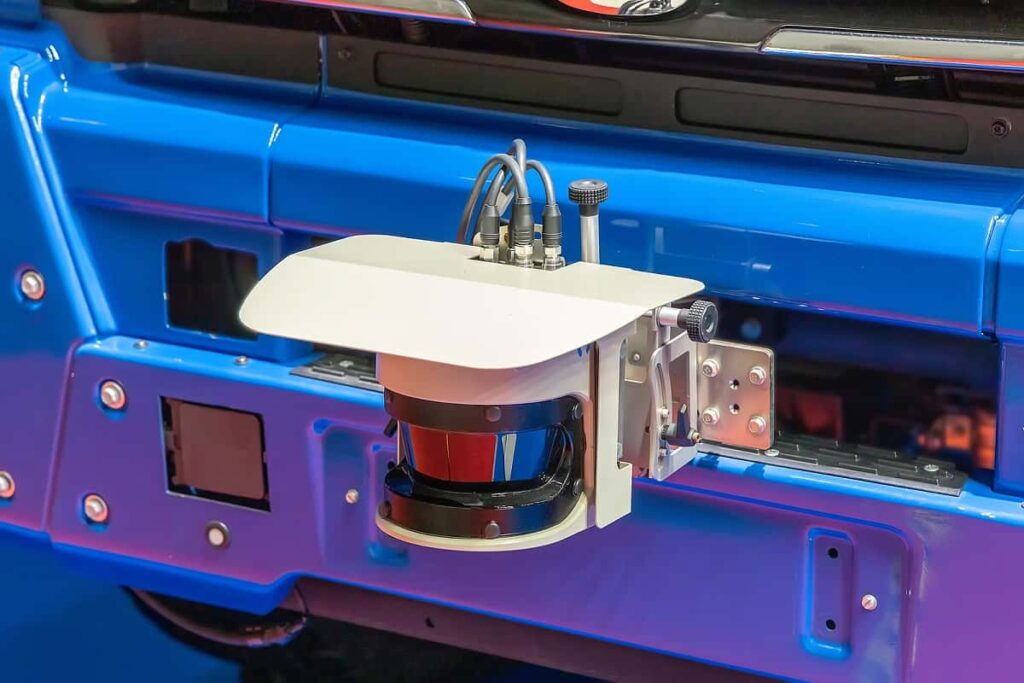Is Ouster Stock the Best Way to Invest in LiDAR?
Table of contents

Managers are expected to make decisions with limited information and do so with conviction. Oftentimes, it’s more important to have an opinion than it is to have the correct answer. MBAs learn this gift of gab by working on case studies where there is no wrong answer. After they graduate, companies pay them to make decisions, sometimes in roles where they aren’t held accountable for outcomes. One good example is estimating the size of total addressable markets (TAMs).
TAM estimates are usually so varied that they’ve largely become useless. One approach to finding the correct answer is by looking for consensus among analysts. For example, here are some data points we pulled together for the size of the global LiDAR opportunity:
- Markets and Markets: $3.4 billion by 2026
- Allied Market Research: $2.9 billion by 2027
- Fortune Business Insights: $6.71 billion by 2026
- Grand View Research: $3.7 billion by 2027
AVERAGE = 4.17 billion
Let’s address the Indian elephant in the room. Many of these research firms have factories of Mumbai analysts (soon to be Manila analysts) churning these market research reports out as fast as possible. It’s less important to find the right answer than it is to have an answer. Then, you have companies like Luminar (LAZR) talking about a $227 billion LiDAR TAM by 2030 of which they plan to target the $180 billion of that which represents highway autonomy.

To put these large estimates in perspective, the eight LiDAR stocks we’ve covered collectively brought in $157 million in revenues during 2021. Whether you believe LiDAR is a $5 billion dollar market or a $50 billion market, we can conclude a number of things:
- The eight publicly traded firms we analyzed have barely tapped into the potential market that exists today.
- Given point one, there’s a lot of growth to be had if a leader can get in front of the competition and capture market share quickly.
- Companies with strong revenue growth will emerge as leaders
That brings us to the best LiDAR stock we’ve found based on our preliminary research thus far – Ouster (OUST).
About Ouster Stock
In our recent article on 8 LiDAR Stocks for Investors to Keep on Their Radar we questioned the size of the potential opportunity while also noting that one company appeared a cut above the rest. Founded in 2015, San Francisco’s own Ouster went public using a SPAC after raising about $132 million in venture capital. We’re going to toss aside their glossy forward-looking investor deck in favor of the 10-K filing they made available in February (nice job getting that out fairly quickly) and see what insights we can derive from it.
It’s Not Just About Auto
Elon Musk famously referred to LiDAR for autonomous cars as a fool’s errand, but plenty of LiDAR manufacturers disagree. What everyone can probably agree on is that LiDAR takes time to implement because of the regulatory restrictions faced by the auto industry. Contrast this to applications such as industrial automation or robotics where the use of LiDAR can happen more seamlessly. Therefore, we would expect that non-automotive use cases will have quicker adoption rates than automotive, and an industry leader will have diversified revenue streams capturing multiple opportunities. It’s one of Ouster’s big selling points as their 2021 revenues were diversified across 600 paying customers in the below verticals (no single customer accounted for more than 10% of their revenue from product sales during 2021):
- 34% – automotive vertical which includes robotaxi, robotrucking, shuttles and buses, and consumer ADAS
- 25% – industrial vertical which includes material handling, off-highway equipment, and factory automation
- 15% – smart infrastructure which includes 86 deployed projects within our intelligent transportation systems, smart places, and security sub-markets
- 26% – robotics which includes last-mile delivery, street sweeping, and asset inspection
Ouster talks about how their strongest growth in 2021 came from the smart infrastructure vertical and references 86 deployed projects. It’s always important to put these numbers in perspective. With 2021 revenues of $33.58 million, and smart infrastructure accounting for 15% of that, back of the napkin math puts revenue for each of these “projects” at $58,569. In other words, these seem to be small pilot projects as opposed to large installations. So, when the company says, “we were also selected for 24 additional smart infrastructure projects in 2021 that are scheduled to be shipped after 2021,” take it with a grain of salt. That said, smart infrastructure is where Ouster sees the biggest potential opportunity as it constitutes one third of the $8.6 billion total 2025 TAM estimates for each segment.

The Automotive Opportunity
We see lots of LiDAR stocks talking about how they’re working with large automakers with riches to come down the road. Investors need to consider that automakers will be testing products from more than one company. For example, Volvo is working with both Luminar (cars) and Ouster (trucks) which brings up another point. Just because an automaker chooses your LiDAR sensor doesn’t mean you can expect a windfall. Luminar is said to be providing LiDAR sensors for the Volvo XC90 which sold 38,657 units in 2021. If LiDAR sensors are priced at $500 per vehicle, that’s a $19.3 million opportunity. If Luminar’s LiDAR was deployed as standard equipment on the 700,000 cars Volvo sold in 2021, that would be a much more respectable $350 million per annum. What companies can expect from deals they’re flaunting is always an unknown. Also consider that LiDAR will soon become a commodity where pricing pressure will reduce revenues over time. In fact, that’s mentioned in the 10-K alongside the below table which shows good international revenue diversification.

Here’s an interesting comment they included with the above table:
The increase in product revenue was driven by an increase in volume of 202%, which we attribute primarily to the expansion of our sales team and the increase of high volume, long-term deals as some of our customers begin to move into the production stage with their autonomous products. Our average selling price declined by 34% as expected as we sell higher volumes and are able to reduce our cost of goods sold per unit.
Credit: Ouster 10-K
While product revenues increased by nearly 100%, unit volumes increased by 202%, because the average selling price dropped by more than a third due to economies of scale. This was the strategy that Velodyne (VLDR) hoped to implement – dropping price over time to spur adoption.
In October of 2021, Ouster acquired Sense Photonics, a developer of solid-state flash lidar which had taken in just over $48 million from names like Samsung and Shell. This led to the establishment of Ouster Automotive, a new functional division of the company focused on driving mass-market adoption of digital lidar in consumer and commercial vehicles. The DF series for consumer vehicles will start production in 2025, so we won’t know whether this purchase made sense for several years.

Should You Buy Ouster Stock?
Since 95% of money managers can’t beat a passive benchmark over the long term, you shouldn’t let anyone tell you what to do with your money. That’s why we came up with our own tech investing methodology which forbids us to invest in stocks with a market cap of less than $1 billion. Ouster is just too small for us to consider right now. That said, we don’t believe they’re overvalued compared to peers based on our simple valuation ratio seen below.
| Company | Market Cap (USD Millions) | Q4-2021 Revenues (USD Millions) | Ratio |
| Luminar | 4,877 | 12.34 | 98 |
| Aeva | 779 | 2.87 | 67 |
| Aeye | 758 | 6.5 | 29 |
| Cepton | 436 | 1.28 | 85 |
| Ouster | 655 | 11.85 | 14 |
| Innoviz | 442 | 1.66 | 66 |
| Velodyne Lidar | 404 | 17.54 | 6 |
| Quanergy | 145 | 3.9 | 9 |
We didn’t see any red flags in the 10-K aside from an SEC investigation that was initiated in June 2021 and doesn’t seem to have gone anywhere.
In addition, on June 10, 2021, we received a letter from the SEC notifying us of an investigation and document subpoena. The subpoena seeks documents regarding projected financial information in CLA’s Form S-4 registration statement filed on December 22, 2020.
Credit: Ouster 10-K
Lastly, be careful about listening to arbitrary price targets from analysts. This is another group of people who need to have an opinion, the accuracy of which isn’t overly important.

We completely disagree with Mr. Michaeli’s latest price target of $17 a share and firmly believe it should be $17.69 a share. Anyone with a modicum of common sense should be able to see that our arbitrary price target is superior to his – unless we change our minds, which could happen at any time and for any reason.
Conclusion
Let’s see if Ouster can hit their aggressive 2022 revenue target of $65 million (lower range of guidance) and how that growth gets spread out across their four verticals. It would be great if they decided to break these segments out in the 10-K and show year-over-year growth for each. If the company manages to pull out in front of the pack and emerges from the size death zone, it could be a worthy addition to a well-diversified disruptive tech stock portfolio.
Sign up to our newsletter to get more of our great research delivered straight to your inbox!
Nanalyze Weekly includes useful insights written by our team of underpaid MBAs, research on new disruptive technology stocks flying under the radar, and summaries of our recent research. Always 100% free.















